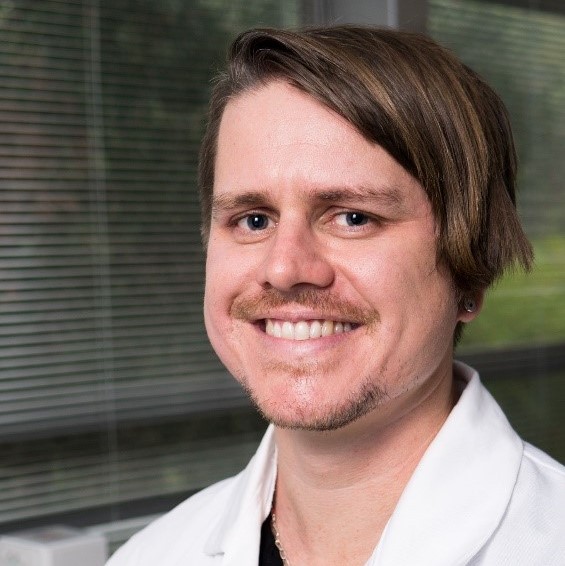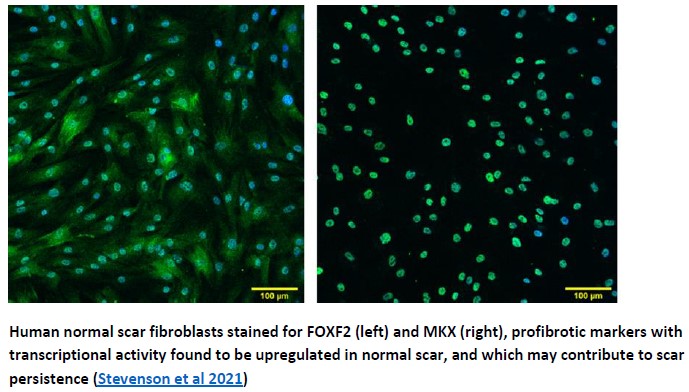 Dr Andrew Stevenson,
Dr Andrew Stevenson,
Burn Injury Research Unit,
University of Western Australia
Andrew is a post-doctoral researcher in the Burn Injury Research Unit, based at the University of Western Australia, which aims to facilitate truly scarless wound healing, prevention of and reversal of fibrosis and ensuring maximum quality of life after injury to the skin. Andrew’s research seeks to achieve this through a lens of cell biology – understanding how to modulate the cells within the wound to regenerate completely, rather than with a fibrotic outcome.
Completing a Bachelor of Science (majoring in Biochemistry and Genetics) and subsequent Honours in Science at the University of Western Australia, Andrew first began researching the effect of ascorbic acid on tympanic membrane fibroblasts for his honours thesis in 2007. Andrew then worked as a research assistant in the Ear Science Centre, part of the Ear Science Institute of Australia (ESIA) for one year before moving to the Burn Injury Repair Unit, part of University of Western Australia’s School of Surgery and working as a research assistant there from 2009 until 2011.
In 2011, Andrew began his PhD research investigating the role of epigenetics in scar maintenance within the same Burn Injury Repair Unit, and was awarded Wound Management CRC top up scholarship for PhD in 2012. The presentation of this research has won Andrew six prizes as a PhD student, and as an EMCR, Andrew has already published his research in 16 peer-reviewed publications, with 239 citations and an h-index of 7 on Scopus. Highlights of his conference presentations as an EMCR include presenting at the 2nd Congress of the Asian Pacific Society for Scar Medicine in Tokyo, Japan, and multiple presentations at the Australia and New Zealand Burns Association (ANZBA) conferences in Brisbane, Hobart and Perth. Andrew was also an invited chair at both the Australian Society for Medical Research WA Scientific Symposium 2021 and the ANZBA Perth 2021 meeting, where he was also a judge of presentations.
Notably, Andrew’s first author paper entitled “A methylome and transcriptome analysis of normal human scar cells reveals a role for FOXF2 in scar maintenance” was recently published in the Journal of Investigative Dermatology, with half of his 16 publications occurring in2020 & 2021 and his review article “The Role of IL-6 in Skin Fibrosis and Cutaneous Wound Healing” has achieved a field-weighted citation of 6.74 on Scopus. Andrew has also logged three datasets with the gene
expression omnibus, which have been shared with international researchers to further the understanding of the molecular mechanism for fibrosis and scar formation. Since becoming an EMCR Andrew was awarded the Life Science Alliance prize for best poster at the Cutaneous Biology Conference, Stradbroke island, QLD, October 2018 and 2 grants– one as chief investigator and one as joint chief investigator, for over $117,000 total funding.
As joint chief investigator, through the Entrepreneur’s Program, Andrew’s project entitled “Enhancing the buccal permeation of Sildenafil and other drugs for oral spray delivery”, and involved and industry collaboration, working with the pharmaceutical company SUDA Ltd testing oral spray formulations of drugs with permeation enhancers and flavours for their permeation capability in an in vitro model of buccal transfer.
Human normal scar fibroblasts stained for FOXF2 (left) and MKX (right), profibrotic markers with transcriptional activity found to be upregulated in normal scar, and which may contribute to scar persistence (Stevenson et al 2021) A member of both the AWTRS as committee member and the Australian and New Zealand Burns Association, Andrew is committed to engaging with burn injury survivors to guide future research efforts. Through the Fiona Wood Foundation, which has funded his work exploring the heterogeneity of keloid fibroblasts, Andrew presents at the 6 monthly research update events, where consumers speak of their experience, to gain insight into the specific areas of need. Through these events, he has established a strong personal relationship with many burn survivors, being able to contact them for their input on my research with ease. His work on fibrosis has also been presented to members of the LIFE lung support group for patients with lung fibrosis.
Andrew is an emerging research leader, currently the co-ordinating supervisor for 1 PhD student, co-supervisor for another and primary supervisor for 2 honours students, and previously supervising 1 masters student, 3 honours students and 1 exchange student. Most recently, Andrew led the organising committee for the AWTRS Symposium which was held on the 5th of November, recruiting two international speakers as well as a host of speakers and across Australia, New Zealand and Singapore.
Andrew is currently working on multiple projects involved in wound healing and scarring, including single cell characterisation of human keloid scars, animal models of 3D bioprinting, the effect of burns on neurons using RNA sequencing and characterising extracellular matrix turnover in scar using deuterated water.
You can follow Andrew on LinkedIn and Twitter (@AndrewStevo86 ) to keep an eye on where his exciting research in Wound and Tissue Repair goes next.
